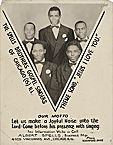| Entries |
| C |
|
Chicago Black Renaissance
|

|
Literature

|
In 1941 Gwendolyn Brooks attended a class on modern poetry that Inez Cunningham Stark conducted at the South Side Community Art Center. Her award a few years later at the Midwestern Writer's Conference led to the publication of her first book of poetry, A Street in Bronzeville. Her next book, Annie Allen, won the Pulitzer Prize in 1950, and in 1968 Brooks was named Poet Laureate of Illinois. In 1969, with the publication of Riot, Brooks began a long association with Haki Madhubuti's Third World Press.
Visual Art
Four early black visual artists, all of whom received training at the School of the Art Institute of Chicago, captured the dynamic spirit of black Chicago: William Edouard Scott, Charles White, Archibald John Motley, Jr., and Eldzier Cortor. Scott painted impressionist landscapes, portraits, and murals, including the murals depicting black achievement on the walls of the Tanner Art Gallery in the Chicago Coliseum when it was the site of the American Negro Exposition in 1940. White worked with the mural division of the Illinois Federal Art Project and became a prominent graphic artist. Motley's early works provoked controversy with his depictions of jazz culture and celebration of black sensuality. His paintings, joyous celebrations of the vitality of urban black life, provide vivid images of black social activities in the 1920s and 1930s. Cortor was among the first African American artists to take the beauty of black women as his major theme. In 1946, Life Magazine published one of his full-length seminude female figures.
Music

|
Thomas Dorsey, known as the “Father of Gospel Music,” wrote over four hundred songs that revitalized black religious music. A distinctly urban music, gospel featured pianos, tambourines, drums, cymbals, and steel tambourines. Contralto Mahalia Jackson was most responsible for the acceptance and widespread popularity of gospel music. She arrived in Chicago in 1927 and by 1945 was selling millions of records featuring Dorsey's compositions, including “Take My Hand, Precious Lord.”
Dance
Dance halls and social clubs became important venues for black Chicagoans who sought release and pleasure after working in stockyards, factories, and steel mills. At the other end of the spectrum, Katherine Dunham organized Ballets Negres and in 1931 presented one of her compositions, “Negro Rhapsody,” at the Beaux Arts Ball in Chicago. In 1945, she founded the Katherine Dunham School of Arts and Research. Dunham's race consciousness and appreciation of black aesthetics emerged in her choreography and her ethnographic studies of West Indian dance.
The Encyclopedia of Chicago © 2004 The Newberry Library. All Rights Reserved. Portions are copyrighted by other institutions and individuals. Additional information on copyright and permissions.